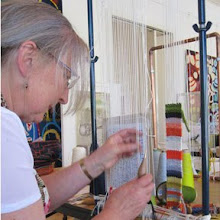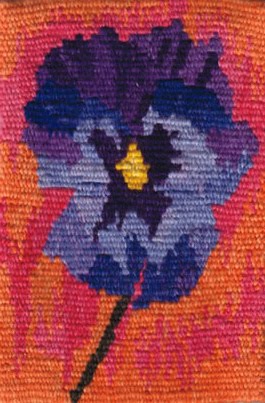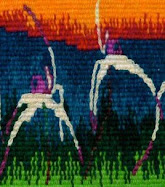I had a very busy week in Melbourne, participating in a Master Class at the A.T.W. Along with surviving the commute from my friend Megs on the train and tram route. Every time I do the 1 hour commute it confirms to me why I live in the country and treasure my view of the mountains.
The class of 10 was made up with many past and present South West Institute of Tafe students. With only 2 members of the class that I had not met before so it was good to catch up with everyone and meet new people. 
Cheryl gave a power point presentation showing tapestries woven at the workshop and talked in length about the production of this David Noonan tapestry.

A beautiful tapestry full of fabulous detail and so many small circles! Cheryl talked about production costs, keeping within the budget provided and working to a time schedule. As well as the all important decision as to weave the image on its side or straight up as the challenges would be different whichever way they chose.
Incredible detail. I have thought a lot since I came home about the restraints of production weaving. Always keeping within budget and time limitations. Constant decision making as to the best approach. My only restrictions are time, cost of materials do come into it, but making money or breaking even are never a consideration. When I was doing my diploma we had to keep records of all our costs and weaving time, adding up to the final cost of the tapestry. I think I was a bit gob smacked by the figure and decided that selling work is not the reason why I weave.
Maybe I should try to become a faster weaver.......but it is all practice.
In the class brief when it was advertised it was suggested that we would cover watercolour and photographic interpretation. Four artists with an association with the workshop gave permission for us to use their imagery. Works from each of the artists, Helen Fuller, John Young, Ian Friend and Jennifer Marshall posed different weaving challenges.
I chose this Helen Fuller still life. The little paintings all reminded me of my mother's tea towels. I chose this painting as a challenge, something to tackle far out of my usual comfort zone. Our first given task was to warp up a 4cm wide colour strip and mix bobbins to form the pallet for our image of choice. I really loved the colours, you can see the completed strip in the first photo.
I chose this Helen Fuller still life. The little paintings all reminded me of my mother's tea towels. I chose this painting as a challenge, something to tackle far out of my usual comfort zone. Our first given task was to warp up a 4cm wide colour strip and mix bobbins to form the pallet for our image of choice. I really loved the colours, you can see the completed strip in the first photo.
I had chosen a 12/18 warp to do my colour strip and in hindsight it was far too course a setting for such a small and detailed image. Rather than rewind my bobbins I chose to just get on with it and weave on a number 18 warp. I did enlarge the image by 20% but that was nowhere near the amount I would tackle to weave the image at home and I would probably weave in to a 12/6. I spoke to Cheryl about facing areas in large tapestries where there is the same amount of detail in areas of the weaving as my little design. So this could be a challenge I may face in the future in my own tapestries. I got to this point and decided to stop sewing up the slits as it was time consuming and I wanted to speed up my weaving.
The Brent Harris tapestry that was on the loom when I visited the workshop earlier in the year is now hanging in their gallery.
The colours in this tapestry are just wonderful, I think that it would have been a lot of fun to weave.
As a part of the week the workshop had organized two evenings of lectures, the first evening Sara Lindsay came and talked about her work. The second lecture was conducted by Cresside Collette. Both founding weavers at the workshop they have both gone on to produce large bodies of their own personal work. No matter how much of an artist's work you see reproduced in books and catalogues or visiting exhibitions. Nothing comes close to hearing the artist speak about their work and the personal stories and inspiration behind each piece.
It was wonderful to spend the week in such an inspiring setting. Although there was no tapping of the bobbins noise in the background as works on the looms are now completed. It was good to be there in a quieter time as the atmosphere was wonderful and relaxed. Restoration work and cleaning was being carried out on tapestries held in a corporate collection. The workshop now sew a fabric backing on their tapestries so it was wonderful of them to take the time and talk us through the process.
Our workspace for the week had such fantastic natural light and as we were in full view it was interesting to see passes by response to our presence there. Many were curious enough to come into the workshop for a better look around.
Well I did choose something complicated, for me anyway. I got a bit lost in some places trying to work out from the cartoon where I was at. I did mention to Cheryl that it would have been a better choice considering the time factor to have woven the image upside down. This would have addressed weaving the less complicated part of the image first. Cheryl pointed out that there are times when you are nearing a deadline that it is a big advantage to have the simpler part at the end! When I began weaving tapestry I was taught that the first half is always the slowest. Time spent sorting colours and shapes, interpreting your design the way you want to see it evolve. In my own experience I have found this to be true. I am not disappointed that I did not complete the tapestry. I DID learn a lot along the way.
The John Wolseley tapestry 'Concerning the wading birds of the Warrnambool wetlands' is still on display at the workshop. You can see an image of the entire tapestry along with parts of the process of weaving this tapestry here.
Just gorgeous is the only way to describe it.
The tapestry was free hanging from the loom but has already had the backing sewn on it. 'End city' were the words used by one of the weavers who worked on the tapestry. There are certainly a lot of colour changes! Years and years of combined experience is what it takes to make such a successful tapestry.
Just look at the 'bleed' of the water colour. How wonderful is that 'splotch' in the bottom left!
It really was a wonderful week. Cheryl is a wonderful teacher, taking time to go around the class and answer questions. Often inviting the class to come and look at problems we each had and how to resolve them. Spending time in such a creative environment soaks the soul. There are a few photos of the class on the A.T.W Facebook page here.
The staff could have not been more friendly or welcoming to each of us. So THANK YOU!
The staff could have not been more friendly or welcoming to each of us. So THANK YOU!
As formal training in tapestry is disappearing from Australian educational institutions, the A.T.W plan to offer more classes. If you have an opportunity, make certain that you take it!






Thank you for sharing Debbie, it's so interesting and wonderful to see those beautiful tapestries too. Love the John Wolseley tapestry - so beautiful! Hope it gave you lots of inspiration and motivation for your own work - happy weaving!
ReplyDeleteThank u Debbie . I woke at twenty past midnight to read your blog from the tapestry yahoo group. I tried the reply 10mins ago but lost what I wrote on this phone. So hope this works. I love the John Woseley tapestry for technical weaving I loved the colours in the Bret Harris and love the design and weave of David Noonan's. I also liked what you said about your Tapestry piece, you learnt to chosE the right warp setting for a design and I may have done part of the design rather the the whole piece to fit into the warp setting. You r a great blogger and weaver aand thank you for shaRing. I have just moved out of my studio to a garage that I rent with my flat in Brighton, England. I miss weaving in natural light since I left a cource I did at West dean college, Englad 2001.
ReplyDeleteThank you
Darren Calder
Hi Vera, the John Wolseley tapestry is a stunner! I feel inspired and ready to start weaving tomorrow!
ReplyDeleteThanks Darren, the tapestries are wonderful. It would be hard to choose which one I like the best. I am glad you enjoyed reading my blog. I know what you mean about working in good natural light. I weave in the lounge room at the moment as my studio is called the 'bat cave' Roof windows would help!
ReplyDeleteGreat post! I love all the VTW tapestries....right now I'm really into black and white so the David Noonan really amazes me. I love what you did for your project, and I think it's a great idea to start at the easier end. I had never considered that possibility.
ReplyDeleteHi Jan, the David Noonan tapestry is ‘’amazing’ I have always wanted to weave a tapestry ‘upside down’ I can remember years ago doing some of the ‘upside down’ exercises in Drawing on the Right Side of the Brain. I was amazed how well they turned out! If I could turn my ‘logic’ brain off when I weave, maybe the tapestry could turn out differently. Its worth a try!
ReplyDeleteHi Deb, I was really sorry to miss out on the workshop, and then not be able to take advantage of the cancellation - it sounds wonderful! Thanks for sharing. I, too, had never thought of weaving upside down - it could be a very interesting exercise, make me less inclined to be so literal. I tend to use photos and need to move on from that. Maybe I will be inspired by you.
ReplyDeleteI like workshops that don't worry about finishing the piece, or coming away with a product. I go to learn and am very happy to do samples or learn techniques. I'll have to keep my eye out for more workshops.
Hi Mary, I did think that I may see you there? It was a great workshop and wonderful to escape from home for a while! I think that working upside down is a great challenge. It tricks the brain!
ReplyDelete